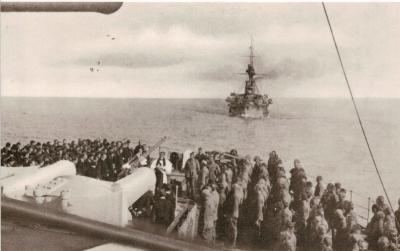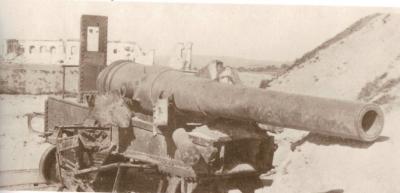World War 1, Eastern Mediterranean, Gallipoli, Anzac Cove, HMS London, 1915
Australians-embarking-on-HMS-London
As part of the attempt to seize the Gallipoli Peninsula in order to suppress the Turkish defences guarding the Dardanelles, military landings were made at Cape Helles at the southern tip of the peninsula (the main landing) and on the west coast near Ari Burnu. At this secondary objective two Divisions of the Australian and New Zealand Army Corps (ANZAC) landed in the darkness and faced rugged and difficult country. Units mixed up on their arrival rushed inland and became separated from the main force, which came under growing fire from the Turkish defenders. While Turkish reinforcements arrived, the ANZAC position became increasingly precarious as the assaulting force failed to secure their initial objectives. Falling back on improvised and shallow entrenchments the ANZACs held on for a crucial first night. By that first evening 16,000 men had been landed; of those over 2,000 Australians had been killed or wounded.
Details
Details
HMS London was the lead ship of the London class of pre-dreadnought battleships built for the British Royal Navy. The ship was laid down in December 1898, was launched in September 1899, and was completed in June 1902. Commissioned the same month, she served with the Mediterranean Fleet until early 1907. Rendered obsolete with the emergence of the new dreadnoughts in late 1906, she underwent an extensive refit in 1909.
Following the outbreak of the World War 1, HMS London was detached in March 1915 to participate in the Dardanelles Campaign, supporting ANZAC forces as they landed at Gaba Tepe and Anzac Cove on 25 April 1915. She remained in the Mediterranean, supporting the Italian Royal Navy in the Adriatic Sea until October 1916.
Australian Army Museum of Western Australia
Australian Army Museum of Western Australia
Other items from Australian Army Museum of Western Australia
- World War 1, Eastern Mediterranean, Egypt / Gallipoli, Suez Canal, 1915
- World War 1, Eastern Mediterranian, Egypt / Gallipoli, Suez Canal, 1915
- World War 1, Eastern Mediterranean, Gallipoli, Anzac Cove, 1915
- World War 1, Eastern Mediterranean, Gallipoli, Cape Helles, 1915
- World War 1, Eastern Mediterranean, Gallipoli, Anzac Cove, 1915
- World War 1, Eastern Mediterranean, Gallipoli, Anzac Cove, HMS London, 1915
- World War 1, Eastern Mediterranean, Gallipoli, Anzac Cove, HMS London, 1915
- World War 1, Eastern Mediterranean, Gallipoli / Mudros Bay, 1915
- World War 2, Eastern Mediterranean, Gallipoli, Cape Helles, Seddul Bahr, 1915
- World War 1, Eastern Mediterranean, Galipolli, Cape Helles, SS River Clyde, 1915
- World War 1, Eastern Mediterranean, Gallipoli, Cape Helles, 1915
- World War 1, Eastern Mediterranian, Gallipoli, Helles, Seddul Bahr, 1915














